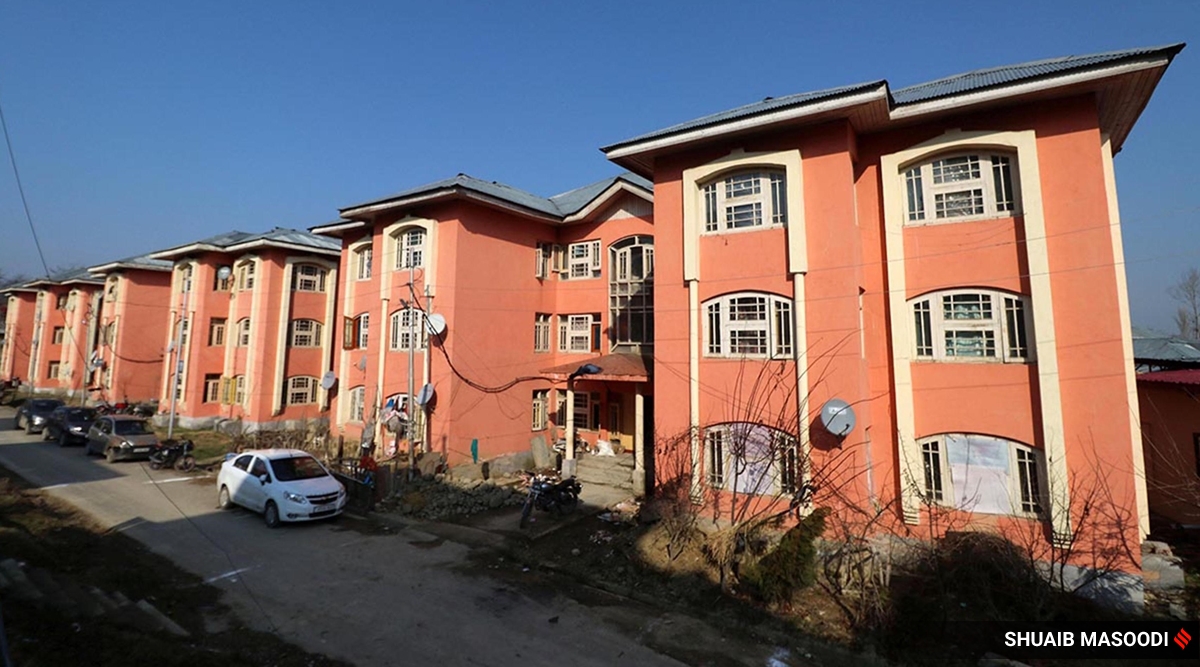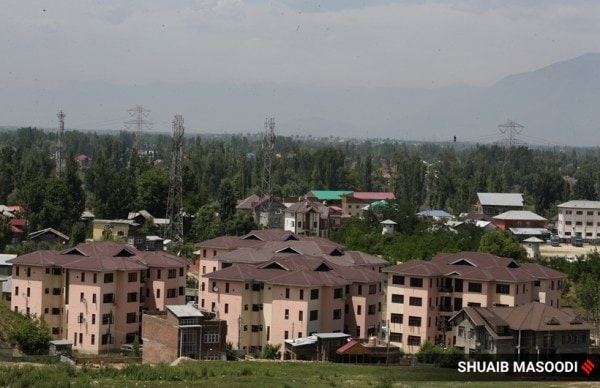 A colony of Kashmiri Pandits in Budgam district. (Express photo by Shuaib Masoodi)
A colony of Kashmiri Pandits in Budgam district. (Express photo by Shuaib Masoodi)Off the main road in Sheikhpora, a narrow stretch leads to a cluster of pink and yellow buildings. Armoured vehicles of the J&K Police and paramilitary forces line the lane and guard the gate to the colony. Policemen ask for the identity of every passerby, allowing one in only after scrutiny. Just inside the gate, about a hundred residents sit under a tent with a picture of Rahul Bhat.
Two days after Bhat was killed inside the tehsil office not far from this residential complex, the anger among the residents is palpable. “Paani sar ke upar se ja chuka hai (We have reached the end of our tether),” says one of the residents, a government schoolteacher, refusing to give his name.
On Saturday, no one from the colony, meant to accommodate Kashmiri Pandit migrants who took up work in the Valley under a Prime Minister’s employment package, went to work. Neither did their children attend school, other than those who had exams.
The demand is unanimous: “If the government cannot provide us a safe environment, it should move us to where we feel safe.” For most, that location is Jammu.
Best of Express Premium
The residents also said that while much gets said about Kashmiri Pandits under every dispensation, “very little gets done”.
Hoping to soothe tempers, Lieutenant Governor Manoj Sinha Friday met Bhat’s family and accepted the demand to provide a job to his wife, and bear the educational expenses of his five-year-old daughter.
But on Saturday, the protest seemed ready for the long haul — not far from where Bhat’s car is still parked in the colony, where he lived for close to a decade. A register went around the tent where people put signs against their names for fund collection to acquire a public address system. The residents explained that many had lost their voices from over two days of sloganeering.
About 300 families live in two-room flats in the Sheikhpora ‘transit accommodation’, many of them sharing a flat. In many families, more than one person is in government service, and several travel for work to different districts, up to 70 km away. Most of them work in the Education, Rural Development and Revenue Departments.
“Some people start as early as 6 am, take the train or bus to far-off places and come back after dark,” says Roshan Lal, whose daughter is a schoolteacher at Anantnag in South Kashmir.
Colonies like Sheikhpora were built exclusively for migrant Pandits moving back to the Valley, to live in ‘transit’ before their reintegration into society. Sheikhpora, among the first, was built 14 years ago and remains the largest such colony, surrounded by a concrete wall topped by concertina wire. When the initial response was poor, the government had moved in over 30 Pandit families from Budgam, who hadn’t migrated from Kashmir, to inspire trust.
The other such fenced colonies are in Vessu in Qazigund, Haal in Pulwama, Mattan in Anantnag, Veervan in Baramulla, Tulmulla in Ganderbal and Nutnusa in Kupwara. Work is on to build six more Pandit colonies — Marhama in Bijbehara, Wandhama in Ganderbal, Fatehpora in Baramulla, Keegam in Shopian, Sumbal in Bandipora and Khullangam in Kupwara.
Perhaps none has seen protests of the kind that broke out on Friday, though few are surprised at the government response that followed. On Friday night, the Sheikhpora colony gates were locked from outside, to keep the residents in after they protested over Bhat’s death, undeterred by police lathicharge and teargas shelling.
“We were told that LG Sinha will come, but he sent his Principal Secretary and that is not enough,” one of the residents says. Principal Secretary Nitishwar Kumar met with the protesters after the Raj Bhavan announced acceptance of their demands.
A resident, Sanjay, says the security personnel first shut the gates on Friday morning itself. “We protested as some parents had to drop their kids to school. Then they opened it.” By 1 pm, the crowds had swelled and asked to be allowed to march till Lal Chowk, the city centre in Srinagar. However, security personnel did not allow them.
Many of the protesters say locals living outside the colony had provided water and support to them as they sat on the road under the sun.
Teenagers Saksham and Kartik, hanging at the edge of the tent holding the protesters, say they missed school willingly Saturday. The two add that they generally do not feel unsafe in Kashmir, neither were they keen to leave, as some of the adults wanted.
However, Rahul’s killing has left most of them feeling vulnerable. “He was a friend to all of us. He was polite, he went to work, took care of his family. He would not be in anyone’s way,” says Sheila.
A resident says they felt caged, with no freedom to move freely, or without fear. “At times, there seems no purpose to these gated colonies. Every day, we have to move out for work, without any security. Our children have to go to school. We may be safe during the night, but we are vulnerable during the day.”
 Colonies like Sheikhpora were built exclusively for migrant Pandits moving back to the Valley, to live in ‘transit’ before their reintegration into society. (Express photo by Shuaib Masoodi)
Colonies like Sheikhpora were built exclusively for migrant Pandits moving back to the Valley, to live in ‘transit’ before their reintegration into society. (Express photo by Shuaib Masoodi) A schoolteacher who lives in the colony talks about fellow Pandit teachers killed earlier, adding: “Every killing is a setback. Now when I go to school, my students worry for me. And when I have a minute to myself, I catch myself looking at the gate to see who is entering.”
He adds that despite years of service, and becoming used to living in gated colonies in a place where people own multi-storey houses, “one can’t live in constant fear”.
A resident says the availability of more secure accommodation facilities has eased some pressure, but living conditions remain bad. At most of the homes, plaster is coming off damp walls. “There are still many instances of families cramped into a single flat. Our life revolves around a few hundred metres. Is this what you call life? It can’t get more miserable than this.”
Pandits who hadn’t migrated from the Valley and were shifted to Sheikhpora say their lives have only got worse. “We are not even treated on a par with others who came from outside,” says one of them. “We are like second-class citizens here.”
- The Indian Express website has been rated GREEN for its credibility and trustworthiness by Newsguard, a global service that rates news sources for their journalistic standards.

